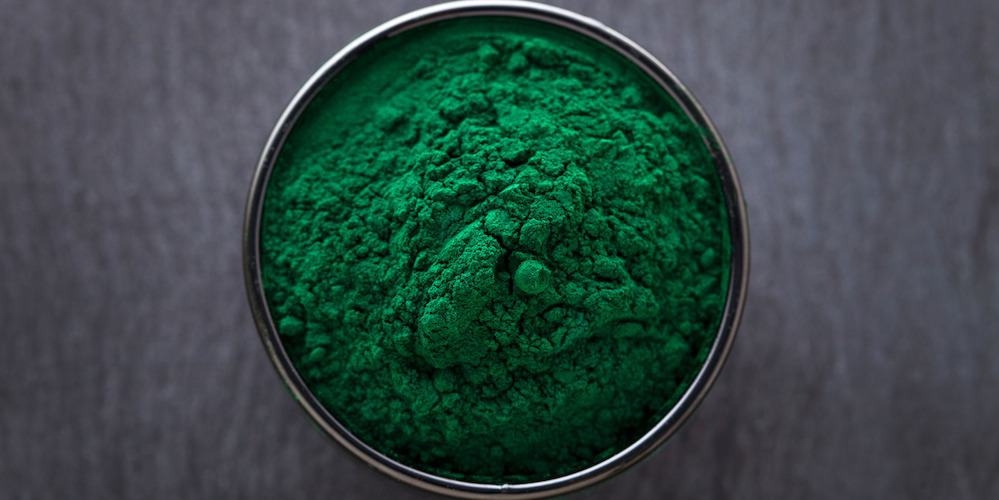SPIRULINA BENEFITS
✓ Highly nutritious and recommended for vegetarians
✓ Fights fatigue and improves athletic performance
✓ Strengthens the immune system
✓ Natural source of antioxidants
✓ Potentially anti-cancer
What is spirulina?
First appearing 3.5 billion years ago, spirulina (Arthrospira platensis) is one of the earliest forms of life on Earth. It is often referred to as an alga (or microalga), but more precisely it belongs to a phylum of cyanobacteria, bacteria capable of photosynthesis — which gives it its blue-green color. Under the microscope, these bacteria, less than one millimeter long, take the form of a spiral — hence its name!
It grows naturally in the freshwater and alkaline lakes of tropical regions, historically in Lake Chad and Lake Texcoco in Mexico. There, the Aztecs, a pre-Columbian civilization from the 12th to the 16th century, were already making them into small, high-energy cakes!

Today spirulina is consumed and cultivated on all continents. Its relatively eco-friendly cultivation can be carried out in artificial ponds and requires little water and space. France is a leader in this area; you can find farm spirulina producers in almost all of our regions. A superfood par excellence, it is also becoming a topic of innovation for multiple start-ups in food tech and is present in many dietary supplements.
Also read the In Bangkok, we discovered a startup that grows spirulina on rooftops
In 2005, the WHO recognized that its high nutritional value, the ease with which it can be cultivated, and its low energy impact make it a major ally in the fight against malnutrition. The UN and NGOs including the Red Cross are developing food relief missions based on this food. But the benefits of spirulina have also attracted NASA’s interest, which has added it to its astronauts’ menu, and the European Space Agency, which intends to grow it on Mars!
Why such enthusiasm? Spirulina is very low in calories, and it is one of the most nutrient-rich foods we know. Above all, it can contain up to 70% protein, about three times more than meat!
And because spirulina has no cell walls, its proteins are highly digestible, at 95%. Along with the proteins, it is probably its very high levels of iron that makes it suitable for vegetarian and vegan diets.
Finally, it is highly valued by athletes and by people wishing to increase their muscle mass. They quickly see their muscles strengthen when they undertake a spirulina regimen.
Also read the Our tips for buying spirulina
Composition of spirulina

- Proteins
- 18 amino acids (including the 8 essential ones)
- Vitamins: B1, B2, B3, B5, B6, B7, B8, B9, pseudo-vitamin B12, E, K
- Minerals and trace elements: calcium, phosphorus, magnesium, iron, zinc, potassium, copper, chromium, manganese, sodium, selenium
- Essential fatty acid: gamma-linolenic acid
- Antioxidant pigments: chlorophyll, phycocyanin, carotenoids (including provitamin A beta-carotene)
Benefits of spirulina

Spirulina is endowed with many benefits: very rich in protein, it also contains many vitamins and minerals. It helps boost athletic performance, is anti-fatigue and may strengthen the immune system.
The phycocyanin it contains, its blue-green pigment, is a powerful antioxidant that helps fight aging by combating free radicals.
In this article you’ll discover the complete list of spirulina’s benefits, as well as the rigorous scientific studies that support its health benefits.
How to consume spirulina

Spirulina is available in many forms: powder, flakes, capsules and even fresh. In powder or flakes it is suitable for cooking and can be easily incorporated into your diet. Ideally it is consumed fresh: its taste is incomparable, and its benefits are fully preserved!
In capsules or tablets, spirulina is more suitable for a supplement regimen: some people don’t like its iodine-like taste, so dietary supplements are a good way to enjoy its benefits.
Our article tells you everything about the different ways to consume spirulina and its taste.
Spirulina, an exceptional source of iron

Spirulina contains 28.5 mg of iron per 100 g, making it one of the richest sources. Furthermore, this type of iron is thought to be highly absorbable by the human body. Consider consuming vitamin C alongside it, which would optimize iron absorption in the small intestine.
Thus it can be useful for people who are iron deficient (iron-deficiency anemia) and for vegetarians, vegans, and others whose intake is limited because their diet contains no meat.
In our dedicated article you’ll find tips to optimize your iron intake with spirulina.
Phycocyanin

Phycocyanin is the blue-green pigment that gives spirulina its beautiful color. It is a particularly potent antioxidant that helps our cells fight free radicals and combat aging. Some studies also show its anti-inflammatory and anti-diabetic properties, as well as benefits for the microbiota and the liver.
To enjoy its benefits, you can consume spirulina as is, or use dietary supplements containing only phycocyanin.
Discover all its benefits and our usage tips in our dedicated article.
Benefits of spirulina for hair

Spirulina is an excellent beauty ally for your hair: the iron it contains helps the body produce keratin, the building block of hair. In addition, B vitamins, vitamin A and zinc are particularly beneficial for hair strength and growth.
To undertake a spirulina regimen to boost the health of your hair, it can be used internally (dietary supplements), or externally by preparing hair masks made from fresh spirulina or powder.
Find our tips and recipes for spirulina hair masks in our article.
Organic spirulina

Given current European rules and the need for certain inputs such as mineral nitrogen, it is now almost impossible for French spirulina producers to certify their production as organic.
Yet you see organic spirulina in stores and on the Internet: they almost always come from abroad, from countries that do not have the same rules as the European Union. This is therefore an important issue for small French producers, who, through the Federation of French Spirulina Growers, are working to change the rules.
Discover all the issues surrounding organic spirulina in our article.
History and cultivation of spirulina

Spirulina grows naturally in lakes, notably in Chad where it has been harvested for over 1,000 years. It was only in the 1960s that the West discovered the nutritional benefits of this cyanobacterium and began cultivating it outside its native environment.
Today there are more than 150 French spirulina producers, who grow it in greenhouses using very little water and few inputs. Spirulina cultivation is indeed particularly eco-friendly, especially when compared with the production of animal proteins.
Read our article on spirulina cultivation to learn more.
Expert opinion
Spirulina is an exceptional source of nutrients. Its levels of protein, iron, vitamins and minerals make it particularly suitable as a supplement to an already well-balanced diet.
Indeed, a superfood, however rich it may be, cannot by itself compensate for a poorly adapted diet! This is especially true for spirulina, which is consumed in limited quantities: about 5 grams per day.
In nutrition, “more” is not necessarily “better”!
💡Proteins: very rich in protein, spirulina is a valuable addition to plant-based diets, particularly those that are predominantly raw. However, people who regularly eat animal-derived foods (meats, dairy products) often consume too much protein. Thus spirulina will probably be less useful for them, but it remains very interesting for the other nutrients it contains.
💡Iron: consuming foods rich in vitamin C (citrus fruits, cabbages, peppers, parsley, but also camu camu, acerola or even goji berries, etc.) helps the absorption of the iron contained in spirulina. However, be careful not to exceed the recommended doses of spirulina, especially in the absence of an iron deficiency!
💡Plant-based diets and vitamin B12: as is known, supplementation is essential when you are vegan. Spirulina should therefore be consumed separately from vitamin B12 supplements. Indeed, it can interfere with its absorption. For example: if you take a daily B12 supplement, take spirulina in the morning and B12 in the evening.
Perrine Bellanger – dietitian nutritionist
Sources and scientific studies
Kalafati M, Jamurtas AZ, Nikolaidis MG, Paschalis V, Theodorou AA, Sakellariou GK, Koutedakis Y, Kouretas D, 2010. Ergogenic and antioxidant effects of spirulina supplementation in humans.
Lu HK, Hsieh CC, Hsu JJ, Yang YK, Chou HN, 2006. Preventive effects of Spirulina platensis on skeletal muscle damage under exercise-induced oxidative stress.
Selmi C, Leung PS, Fischer L, German B, Yang CY, Kenny TP, Cysewski GR, Gershwin ME, 2011. The effects of Spirulina on anemia and immune function in senior citizens.
Romay Ch, González R, Ledón N, Remirez D, Rimbau V, 2003. C-phycocyanin: a biliprotein with antioxidant, anti-inflammatory and neuroprotective effects.
Mathew B, Sankaranarayanan R, Nair PP, Varghese C, Somanathan T, Amma BP, Amma NS, Nair MK, 1995. Evaluation of chemoprevention of oral cancer with Spirulina fusiformis.
Park HJ, Lee YJ, Ryu HK, Kim MH, Chung HW, Kim WY, 2008. A randomized double-blind, placebo-controlled study to establish the effects of spirulina in elderly Koreans.
Cingi C, Conk-Dalay M, Cakli H, Bal C, 2008. The effects of spirulina on allergic rhinitis.
Khan Z, Bhadouria P, Bisen PS. Nutritional and therapeutic potential of Spirulina. Curr Pharm Biotechnol. 2005 Oct;6(5):373-9.
Natural Standard (Ed). Herbs & Supplements – Spirulina, Nature Medicine Quality Standard.
Ripley D. Fox. Pioneer in Production of Spirulina for Combatting Malnutrition.
The Natural Pharmacist (Ed). Natural Products Encyclopedia, Herbs & Supplements – Spirulina, ConsumerLab.com.
CIQUAL



